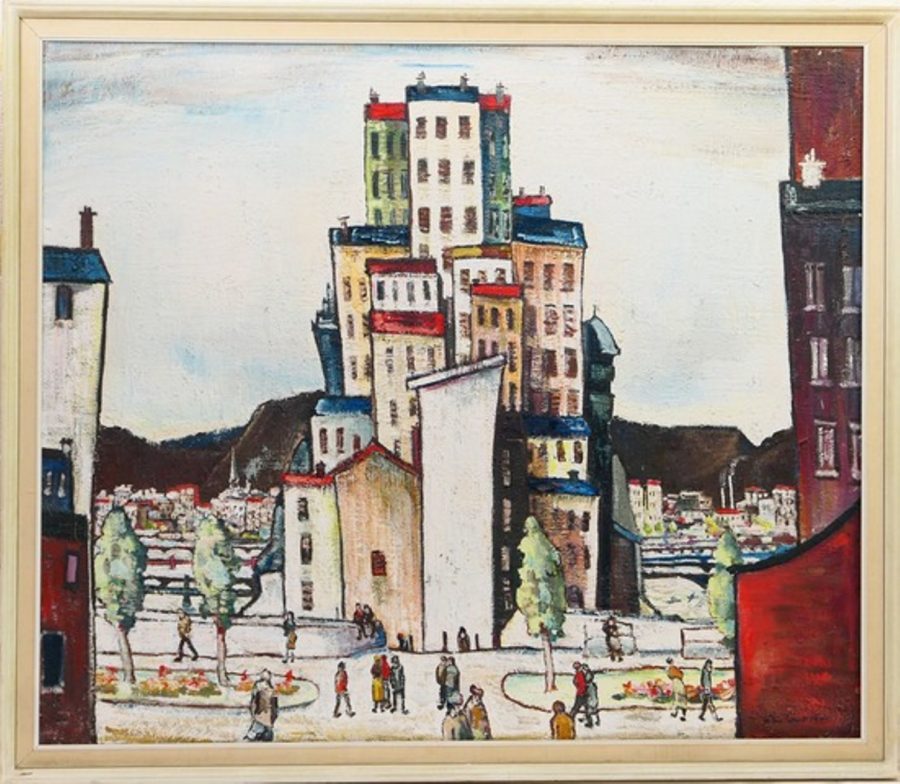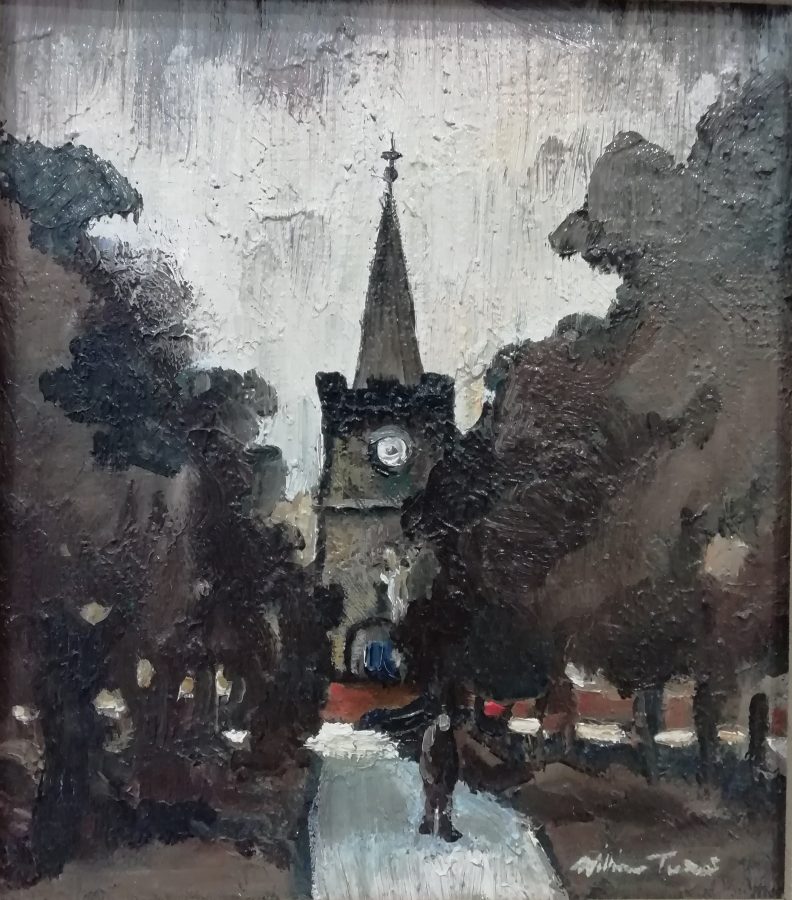William Ralph Turner (1920-2013)
Wendy Levy says:
The paintings on this page show two aspects of William Turner’s work. One is painted in the palette of his northern industrial paintings but the subject matter is of a country scene in Cheshire, ‘Chelford Church’.
‘Lyon’ is a large painting which the artist made in 1973 during his sojourn in Lyon in preparation for his solo show at the Pitcairn Galleries in 1974. As I was a part of the Pitcairn Galleries in those days I had the great pleasure of spending a week with Bill and his wife, Anne, whilst he was gathering subject matter for his show. Every time a see one of his paintings from that period it brings back so many lovely memories.
Read more
A Biography, with personal recollections by Wendy Levy
Born in Manchester in 1920, William Turner knew he wanted to be an artist from a very early age. When in his teens he was experimenting with oil paints. Painting eventually became a passion, along with cycling.
He gained inspiration from looking at the work of artists such as Ivon Hitchins, Matthew Smith, Vlaminck, Utrillo, Soutine, amongst other famous artists.
In the late 1950’s his work was exhibited in Manchester, at Gibbs Bookshop and in 1960 at The Tib Lane Gallery.
During this period he taught art at Hulme Hall Grammar School but left in the 1970’s to concentrate on his own painting career. One of his pupils was Helen Clapcott who went on to become a very successful artist.
His paintings were often produced from memory, portraying the industrial scenes of the 1930’s and 40’s; men at factory gates looking heavily burdened with toil – in much the same way as Josef Herman’s paintings of peasants.
He knew L.S. Lowry and the two artists shared an interest in depicting the northern industrial scene, although Turner wanted to portray much more movement in his paintings. This is probably because many of the scenes he recreated were initially viewed from his bicycle, with his head and shoulders dropped to the handlebars as he raced at speed – I remember him telling me that from that viewpoint the buildings appeared to lean and sway in different directions.
In 1962 he had a show at the Woodstock Gallery in London which received critical acclaim.
He was invited to exhibit at the Pitcairn Galleries in Knutsford in 1971 by Peter Burdett, the founder of the gallery. Indeed the gallery was in its infancy and I had been invited, at 20 years old, to help in the running of the gallery, eventually taking the gallery on as my own. Bill Turner and his wife, Anne, were regular visitors to the gallery, every Saturday, before they went off to the Speedway Stadium at Belle Vue.
Turner had an annual solo exhibition at the Pitcairn Galleries from 1971 until 1985, with L.S. Lowry coming to visit one of his early exhibitions.
In 1973 Peter Burdett commissioned Bill Turner to go to Lyon in France for a couple of months to prepare a collection of paintings for his solo show at the Pitcairn Galleries in 1974. I had the great pleasure of joining Bill and his wife, Anne, for a week during their stay in Lyon. It remains one of my fondest memories. It was wonderful to see how the new environment, the light, the people and the French wine brought new life to Bill’s paintings.
In the same year, Peter Burdett asked Bill Turner to paint the portrait of L.S. Lowry, which Turner completed in 1974.
Later in his career William Turner was taken on by David Gunning of Todmorden Fine Art who sold a huge number of paintings that would sustain the artist until his death at 93 years of age. He had gained well-deserved recognition and widespread acclaim.
William Turner was a member of the Manchester Academy of Art and in 1980 was elected a Fellow of the Royal Society of Art. In 1981 he became an Associate of the Royal Cambrian Academy and in 1988 was elected a full member of that Academy.
His work is to be found in public and private collections including those of Sir Peter Ustinov, Sebastian Coe, Eddy Shah, Freddy Pye, Stockport Art Gallery, Saab Motors, Manchester Education Committee, to name but a few in the UK, as well as those throughout Europe, in the USA and other parts of the world.
Contact Wendy J Levy Fine Art
If you are interested in an artist / piece of art and would like to know more or secure it, please complete this quick form and we will be back to you as soon as possible. Alternatively, call 07773 121 574 for an even more immediate response.


